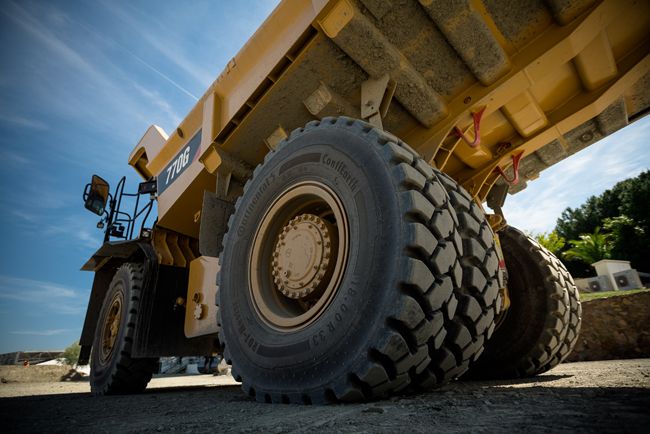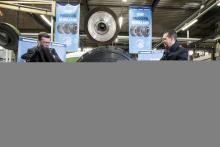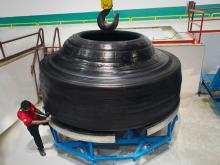
One leading global off-highway equipment tyre manufacturer has big plans for its recently inaugurated cutting-edge research laboratory. Meanwhile, new tyre-performance monitoring systems are being made available to quarrying and mining fleet owners. Guy Woodford reports.
After the ground-breaking ceremony in November 2017, the building covering an area of 30,000m² was ready for occupation, as planned, just one year later. It will house future research on the farming and the extraction process for Russian dandelion as an alternative to tropical rubber as a raw material source for tyres.
If test results are positive, Continental plans to introduce the raw material into serial production within ten years, allowing the firm to obtain an increased proportion of its natural rubber requirement from the dandelion plant.
At the research laboratory opening, Nikolai Setzer, member of the executive board of Continental and head of the Tyre division, said: “We are the first tyre manufacturer in the world to invest such a significant amount in industrialising dandelion rubber. We see Russian dandelion as an important alternative and complementary to conventional natural rubber from hevea brasiliensis, allowing us to meet rising global demand in an environmentally compatible and reliable way.”
Additionally, the €35 million investment in the new research laboratory is another technological milestone on the road to implementing the Vision 2025 strategy Continental has developed for its tyre business. “As part of our Vision 2025 strategy, we have invested far more than €2 billion in production, research and development as well as in jobs and new products worldwide since 2011. 2018, Anklam now features prominently in the series of unique projects in Europe, America, and Asia,” highlighted Setzer.
In the medium term, around 20 employees with background in agricultural sciences, chemistry, and production and process technology will research plant cultivation as well as developing, setting up, and operating machines for processing Russian dandelion at the new location. The Ministry of Economic Affairs for Mecklenburg-Western Pomerania supported the future-oriented project with €11.6 million. This is helping create high-quality local jobs. The new business location also creates opportunities for farmers in the region and their cultivation areas, too.
“We have been working to understand the molecular basis of the rubber biosynthesis in the dandelion plant for many years. This biological understanding has now brought industrial use within reach. With the new test laboratory Continental has broken new ground that makes this transfer concept highly visible,” emphasised Dirk Prüfer, professor of Plant Biotechnology at the University of Münster (Westfälische Wilhelms-Universität Münster – WWU) and site director of the Fraunhofer Institute for Molecular Biology and Applied Ecology IME, Münster branch.
Continental has been conducting research into replacing natural rubber from the tropics with plants which can be grown in moderate climates since 2011, in collaboration with the Fraunhofer Institute IME in Münster, the Julius Kühn-Institute in Quedlinburg, the plant breeder ESKUSA in Parkstetten and other partners in various research projects, with support from the German Federal Ministry of Education and Research as well as the German Federal Ministry of Food and Agriculture. The first sample of a premium winter tyre featuring a tread made from pure dandelion rubber was brought onto the road in 2014. The first truck tyre with a tread made from Taraxagum then followed at IAA 2016.
In other Continental news, the company has launched a new compound for its RDT-Master tyres for rigid dump trucks (RDTs). The cut-resistant compound was developed for rough and abrasive applications where tyres need to withstand sharp gravel, rocks and stones.
Thanks to the newly developed polymer-meshing system based on high synthetic rubber and selected components, the RDT-Master cut-resistant compound is said to offer excellent protection and wear resistance in rough applications, while still maintaining good levels of heat dissipation.
The new compound complements the standard compound for the RDT-Master, which is the best choice for mixed applications.
As Indian global off-highway tyre market manufacturer Balkrishna Industries Ltd (BKT) notes, monitoring tools have been created to turn subjective takes on equipment performance into objective comparative data. BKT’s new SPOTech solution is an innovative, easy and quick to install technology for quarrying, mining and port applications.
Using a GPS system, a GoPro Camera and a triaxial accelerometer, SPOTech (Satellite Performance Optimisation Technology) can, for example, monitor mine or quarry haul truck journeys along haul roads and create a productivity study to help companies identify ways of reducing operational costs. SPOTech can also be programmed and tailored to an application site’s volumes and type of equipment in use. A triaxial accelerometer positioned on the haul truck records latitudinal, longitudinal, and vertical movements, as well as the forces involved in addition to speed, cycle duration and other useful parameters.
The fact that haul trucks on quarry and mine sites generally perform repeated cycles enables SPOTech to assess TKPH (Tonne-Kilometres Per Hour) value by analysing and comparing the average weight transported to the hauler’s average kilometres per hour over a specific distance. Basically, a higher TKPH index means that a tyre is not suited to its current application. BKT experts can assist SPOTech users by offering practical suggestions on how to correctly interpret the data and to intervene, if necessary, to fix specific problems hindering tyre performance.
Chris Rhoades, BKT senior product manager, said: “Since our tyre lines are available in many sizes and patterns, it is important to choose the most suitable tyre. Which operations should the tyre perform? Where will it operate? The answers to the questions can help our BKT team to offer our customers the best solution. Wouldn’t it be cool if our equipment could let us know what it needs? It’s right here that SPOTech comes into play.”
BKT says that the use of SPOTech saved one company up to US$11 million a year in lost productivity after identifying an uneven haul road that had been causing haul trucks to slow down to ensure they reached their destinations safely. By fixing the haul road, the haul trucks could travel at a higher yet still safe speed, significantly increasing productivity. The new even haul road also improved the working life of the tyres.
Other major tyre producers have introduced their own range of tyre monitoring solutions.
Goodyear has launched a significantly enhanced version of its EMTrack OTR tyre monitoring system. “The completely updated Goodyear EMTrack tyre-performance monitoring system enables faster and even more accurate collection of critical tyre data like tread depth, inflation levels and other indicators,” said Eric Matson, global field engineering manager, Goodyear.
He continued: “The enhanced EMTrack system also offers convenient, cloud-based data storage and more robust reporting capabilities thanks to the addition of the new Goodyear EMTrack App. This gives mining, construction, quarry and port operators an enhanced platform, so they can make even more informed decisions about their valuable tyre assets.”
The Goodyear EMTrack system initially sees trained Goodyear tyre technicians performing fleet surveys, using a special Goodyear EMTrack scanning tool to capture tyre inflation, tread depth and other critical measurements.
Tyre-performance data automatically uploads via Bluetooth to a cloud-based platform for password-protected storage and easy access.
End users download the data into easy-to-read, customisable reports that show tyre performance.
“Through the Goodyear EMTrack App, a user can view collected tyre data and reports simultaneously and in real time, regardless of their geographic location, for complete visibility,” said Matson.
End users can view performance data for their tyres across their operation and even zero in on specific tyres, calculating cost per hour, cost per tonne and other key metrics.
“Among other benefits, this will help end users identify, if applicable, maintenance opportunities to help ensure optimal tyre performance,” explained Matson. “And the information collected through Goodyear EMTrack can also help in forecasting future tyre requirements.
“The needs of our customers are continually evolving,” Matson added. “The trusted products, worldwide support, reliable services and management tools that Goodyear offers – such as EMTrack – are also evolving. We are confident that the enhanced Goodyear EMTrack system can help improve end users’ operational efficiency and help lower their operating costs.”
Dutch off-highway tyre producer Magna Tyres reports that a Spanish quarry operator is reducing its hourly operating costs using 18.00R33 steel radial Magna MA04 premium tyres with E4 pattern on its rigid dump trucks (RDTs). The RDTs are used in demanding circumstances for heavy transport purposes within the Spanish customer’s quarry site.
Despite the intensive and frequent usage, Magna Tyres reports that the tyres are perfectly and equally worn to the end of their working life. A new set of Magna MA04 tyres was recently delivered to the Spanish quarry customer and mounted on the RDTs by Magna Tyres’ Spanish distributor.
The Spanish quarry customer is satisfied with the Magna MA04 tyres’ ability to lower hourly RDT operating costs and the overall performance of the tyres has led to a further investment in 23.5R25 Magna MA01 premium tyres for their quarry wheeled loader fleet.
The Magna MA04 is specially designed for dump trucks in heavy-duty mining and quarrying conditions. The improved shoulder and sidewall protection offers excellent resistance to damage, and different compounds are available to optimize performance for different applications.
The Magna MA01 is designed for use on wheeled loaders, dozers, scrapers and graders. An aggressive non-directional tread pattern provides superior traction in soft underfoot conditions. The tread compound provides excellent protection against cutting and abrasion.









